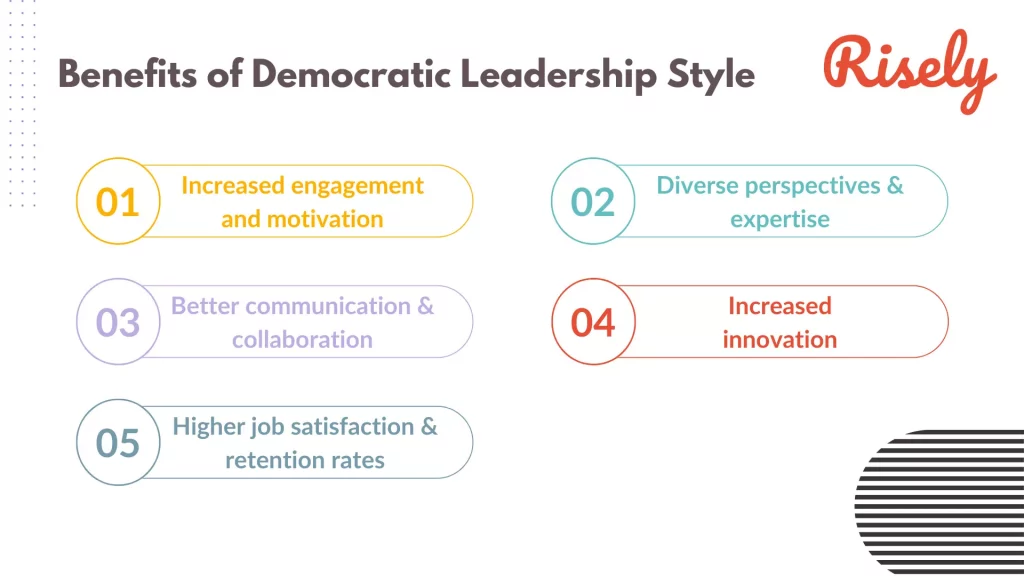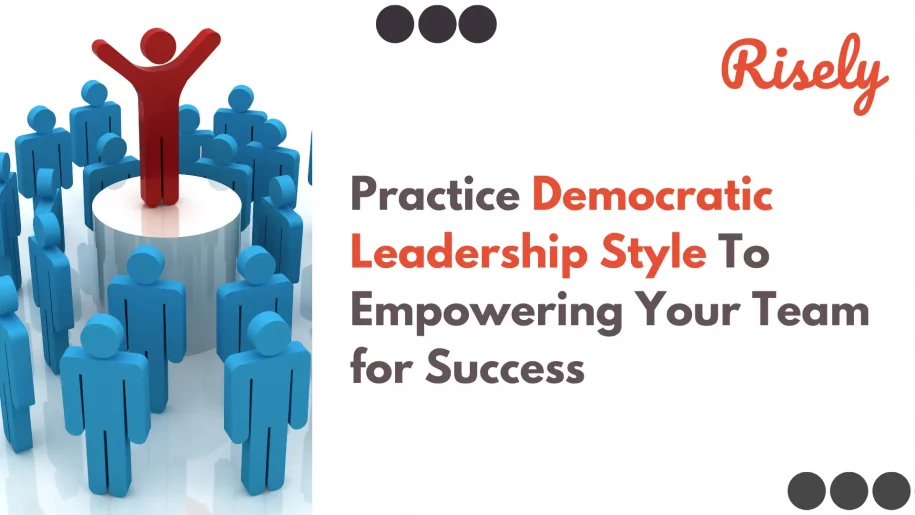Practice Democratic Leadership Style To Empowering Your Team for Success
Have you ever worked under a leader who valued your opinions and empowered you to make decisions? How did it make you feel? Chances are, you felt more engaged, motivated, and committed to the team or organization’s success. This is the essence of democratic leadership – a style of leadership that values collaboration, open communication, and team involvement in the decision-making process. In this blog, we will explore the benefits and drawbacks of democratic leadership, examine successful examples of participative leaders, and provide practical tips for implementing this leadership style in your workplace. So, let’s dive in and discover how democratic style leadership can transform your organization!- Practice Democratic Leadership Style To Empowering Your Team for Success
- What is the democratic leadership style in the workplace?
- How Democratic Leadership Fosters Inclusion and Participation
- Benefits of the Democratic Leadership Style
- Implementing Democratic Leadership in the Workplace
- Examples of Successful Participative Leaders at Work
- Pros and Cons of Group Decision Making in Participative Leadership
- Conclusion
- FAQs
- Other Related Blogs
What is the democratic leadership style in the workplace?
The democratic leadership style or participative leadership emphasizes collaboration and participation in decision-making processes. In this leadership style, leaders must actively seek input and feedback from team members and decide based on the group’s consensus. One of the key characteristics of democratic style is its emphasis on inclusion and equality. Every team member’s contribution, regardless of position or seniority, and encourages them to share their ideas and opinions are valued. This creates a sense of ownership and engagement among team members, who feel their voices are heard, and their ideas are respected. But a democratic leadership style also does not appropriately fit all situations, such as in crisis or emergencies; a more directive approach should be preferred instead of participative leadership. A democratic leadership style is a practical approach for leaders valuing collaboration and workplace participation. By creating a culture of inclusion and equality, leaders can foster a positive and productive work environment that benefits everyone involved.Other Interesting Reads
How Democratic Leadership Fosters Inclusion and Participation
Democratic leadership plays a significant role in fostering inclusion and participation among team members regardless of their position or background. This leadership style encourages the active involvement of all team members, creating a sense of ownership and accountability. It promotes open communication and transparency, where diverse perspectives are valued and heard. This inclusivity culture helps break down barriers by facilitating collaboration and empowering employees from different backgrounds. By encouraging the active involvement of all the team members and creating a sense of ownership and accountability, a democratic leader fosters the inclusion and participation of all the team members regardless of their position. Through this, the team can communicate effectively, and transparency builds employees’ trust in the leader and organization. Empowering team members by including them in decision-making brings unique ideas and promotes innovative thinking. By practicing democratic style leadership, you can promote an environment that values diversity, collaboration, creativity, and inclusivity.Benefits of the Democratic Leadership Style
The democratic leadership style, or participative leadership, can bring numerous benefits to a workplace environment, such as;
- Increased engagement and motivation: By involving team members in decision-making processes, employees feel that their opinions and ideas are valued, which increases engagement and motivation, and they are more likely to be invested in the organization’s success. This can lead to higher job satisfaction and lower turnover rates.
- Diverse perspectives and expertise: The democratic leadership style values input from all team members, regardless of their position or seniority. This brings a wider range of perspectives and expertise, ultimately bringing a creative problem-solving and decision-making approach.
- Better communication and collaboration: When team members are involved in decision-making, they are likely to communicate and collaborate effectively. This leads to a more cohesive and productive team, with everyone working to achieve a common goal.
- Increased innovation: The democratic leadership style encourages innovation by creating a culture that values experimentation and risk-taking. Team members feel their ideas are being heard and valued; they are more likely to develop creative solutions to problems.
- Higher job satisfaction and retention rates: Employees feel valued, and the leader appreciates their contribution, creating a good work environment, ultimately leading to higher job satisfaction and retention rate.

Implementing Democratic Leadership in the Workplace
Democratic leadership style involves the inclusion of team members in the decision-making process. It is characterized by open communication, collaboration, and a willingness to share responsibilities. By practicing the steps mentioned below, you can implement democratic leadership in the workplace;- Creating a culture of open communication, encouraging employees to speak up in meetings, and providing constructive feedback.
- Empower employees by giving them the authority to make decisions and take ownership of their work.
- Set clear expectations by communicating clear goals and expectations to employees and providing them with the necessary information to achieve those goals.
- Recognize and reward employees for their contributions and achievements to boost their morale and foster a culture of collaboration and teamwork.
- Be open to feedback, collaborate with employees, and involve them in decision-making. This will set the tone for the rest of the team and create a culture of democratic leadership.
Examples of Successful Participative Leaders at Work
There are many successful participative leaders across a variety of industries. Here are a few examples:- Mary Barra, CEO of General Motors: Barra is known for her participative leadership style and commitment to empowering employees. She has implemented many initiatives to encourage collaboration and teamwork, including cross-functional teams and employee suggestion programs.
- Tony Hsieh, former CEO of Zappos: Hsieh strongly believed in participative leadership and encouraged his employees to share their ideas and take ownership of their work. He also implemented a unique management structure that gave employees a say in the company’s decision-making process.
- Richard Branson, Founder of Virgin Group: Branson is a participative leader who encourages his employees to share their ideas and take ownership of their work. He also values open communication and takes a collaborative approach to decision-making.
Why a leader relies on group participation?
Leaders relying on group participation benefits the organization in several, such as;- Enhances collaboration and creativity in the team.
- Employees feel valued and heard while sharing ideas or opinions, boosting engagement and motivation among the team.
- Creates a sense of ownership and accountability, driving commitment and success.
- It promotes a positive and productive work environment.
- Unlocks the team’s full potential, driving innovation, growth, and success for the organization.
Pros and Cons of Group Decision Making in Participative Leadership
Group decision making is a key feature of participative style leadership. However, while this approach has many advantages, there are also some potential drawbacks. Here are some pros and cons of group decision-making in participative style leadership:Pros:
- Diverse perspectives: Group decision-making allows for various perspectives, leading to a more well-rounded decision considering multiple viewpoints.
- Increased creativity: Group decision-making can lead to more innovative solutions, as team members can build off each other’s ideas and develop more creative solutions.
- Higher engagement: Involving team members in decision-making increases employee engagement and motivation, as team members feel valued and heard.
- Improved communication: It fosters better communication among team members, leading to improved collaboration and teamwork.
- Higher-quality decisions: When team members are involved in the decision-making process, they are more likely to be invested in the outcome, leading to higher-quality decisions.
Cons:
- Time-consuming: Group decision-making can be time-consuming, especially if many team members are involved. This can lead to delays in decision-making and implementation.
- Conflicting viewpoints: When there are many perspectives to consider, it can be challenging to reach a consensus. This can lead to conflicts and disagreements among team members.
- Groupthink: Group decision-making can sometimes lead to groupthink, where team members conform to the group’s opinions rather than express their views.
- Inefficient: In some cases, group decision-making can be less efficient than individual decision-making, as it requires more time and resources.
- Lack of accountability: With many team members involved, it can be difficult to assign accountability for decisions made by the group, which can lead to a lack of accountability and responsibility.
Conclusion
The democratic leadership style empowers employees by involving them in decision-making, increasing engagement and motivation. It also improves communication and collaboration skills across teams. However, there could be some drawbacks to practicing this leadership style, such as conflicts and groupthink, which can be mitigated through effective communication and clear decision-making. Sign up for Risely and learn about other leadership styles and development techniques.Build democracy in your teams by encouraging constructive feedback.
Get the free constructive feedback toolkit for managers and leaders to unlock resources that fuel success.
FAQs
What is democratic leadership like?
Democratic leadership involves a collaborative approach where the leader values and seeks input from team members, fosters open communication, and supports collective decision-making to achieve shared goals.
What are the 4 democratic leadership styles?
The four democratic leadership styles are consultative, participative, consensus, and delegated. Each involves varying degrees of input and decision-making authority shared between the leader and team members.
Why is democratic leadership style important?
Democratic leadership is important because it values input and participation from all team members, promotes collaboration and creativity, and fosters a sense of ownership and accountability.
Other Related Blogs
What Is A Coercive Leadership Style? 5 Examples To Beat Common Mistakes
What Is A Coercive Leadership Style? 5 Examples To Beat Common Mistakes Has your manager ever threatened or intimidated you to get things done? Or have you seen a team…
Are you a motivated leader? Find 6 traits here to become one
Are you a motivated leader? Find 6 traits here to become one A motivated leader is not just someone who leads a team but someone who inspires their team to…
Building Teams with a Collaborative Leadership Style: All You Need to Know
Building Teams with a Collaborative Leadership Style: All You Need to Know Collaborative leadership is becoming increasingly popular as businesses recognize the importance of teamwork and collaboration in achieving success.…
7 Expert Tips for Becoming Persuasive Leaders and Inspiring Success
7 Expert Tips for Becoming Persuasive Leaders and Inspiring Success Are you ready to take on a leadership role that inspires and motivates your team to achieve great things? One…


